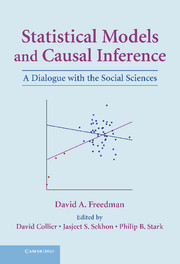Book contents
- Frontmatter
- Contents
- Preface
- Editors' Introduction: Inference and Shoe Leather
- Part I Statistical Modeling: Foundations and Limitations
- 1 Issues in the Foundations of Statistics: Probability and Statistical Models
- 2 Statistical Assumptions as Empirical Commitments
- 3 Statistical Models and Shoe Leather
- Part II Studies in Political Science, Public Policy, and Epidemiology
- Part III New Developments: Progress or Regress?
- Part IV Shoe Leather Revisited
- References and Further Reading
- Index
3 - Statistical Models and Shoe Leather
Published online by Cambridge University Press: 05 June 2012
- Frontmatter
- Contents
- Preface
- Editors' Introduction: Inference and Shoe Leather
- Part I Statistical Modeling: Foundations and Limitations
- 1 Issues in the Foundations of Statistics: Probability and Statistical Models
- 2 Statistical Assumptions as Empirical Commitments
- 3 Statistical Models and Shoe Leather
- Part II Studies in Political Science, Public Policy, and Epidemiology
- Part III New Developments: Progress or Regress?
- Part IV Shoe Leather Revisited
- References and Further Reading
- Index
Summary
Abstract. Regression models have been used in the social sciences at least since 1899, when Yule published a paper on the causes of pauperism. Regression models are now used to make causal arguments in a wide variety of applications, and it is perhaps time to evaluate the results. No definitive answers can be given, but this chapter takes a rather negative view. Snow's work on cholera is presented as a success story for scientific reasoning based on nonexperimental data. Failure stories are also discussed, and comparisons may provide some insight. In particular, this chapter suggests that statistical technique can seldom be an adequate substitute for good design, relevant data, and testing predictions against reality in a variety of settings.
Introduction
Regression models have been used in social sciences at least since 1899, when Yule published his paper on changes in “out-relief” as a cause of pauperism: He argued that providing income support outside the poorhouse increased the number of people on relief. At present, regression models are used to make causal arguments in a wide variety of social science applications, and it is perhaps time to evaluate the results.
A crude four-point scale may be useful:
Regression usually works, although it is (like anything else) imperfect and may sometimes go wrong.
Regression sometimes works in the hands of skillful practitioners, but it isn't suitable for routine use.
Regression might work, but it hasn't yet.
Regression can't work.
- Type
- Chapter
- Information
- Statistical Models and Causal InferenceA Dialogue with the Social Sciences, pp. 45 - 62Publisher: Cambridge University PressPrint publication year: 2009
- 3
- Cited by



